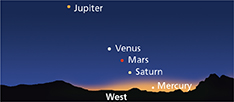CHAPTER 25 Assessment
Reviewing Content
Choose the letter that best answers the question or completes the statement.
In the geocentric model,
Earth travels around the sun.
the planets travel around Earth.
the planets travel around the sun.
the planets travel around the stars.
Which of the following scientists discovered that each planet orbits the sun in an ellipse?
Isaac Newton
Nicolaus Copernicus
Galileo Galilei
Johannes Kepler
Most of the mass of the solar system is contained in
the outer planets.
the moons.
the sun.
Earth.
Dark, smooth regions on the moon are called
maria.
highlands.
craters.
meteoroids.
All the terrestrial planets have
liquid oceans.
liquid helium.
rocky surfaces.
at least one moon.
On Venus and Mars, the major component of the atmosphere is
oxygen.
carbon dioxide.
nitrogen.
hydrogen.
Asteroids are most likely to be
remnants of the early solar system.
former moons of Jupiter.
the remains of a shattered planet.
captured comets.
The gas giants are made mostly of
helium gas.
methane ice crystals.
carbon dioxide.
liquid hydrogen and helium.
The most likely place in the solar system besides Earth to support life is
Jupiter.
Titan.
Venus.
Europa.
The process by which planetesimals combine with other planetesimals is called
condensation.
accretion.
contraction.
fusion.
Understanding Concepts
Why was the heliocentric model of the solar system not readily accepted at first?

Explain why on some occasions you can see the planets line up in the sky.
Why are space probes used to explore the solar system?
Why does the moon lack an atmosphere?
What causes the moon to go through a regular cycle of phases?
Why doesn't a solar eclipse occur every time the moon passes between the sun and Earth?
In most coastal areas there are two high tides every day. What causes the two tides?
What does it mean to say that Mercury is “geologically quiet”?
Why is there no liquid water on the surface of Venus?
Where would you go to find the largest volcano in the solar system?
What is the Great Red Spot in the atmosphere of Jupiter?
Why are hydrogen and helium within the gas giant planets largely in a liquid state?
How are clouds on Neptune different from those on Earth?
What is unusual about the orbit of Pluto around the sun?
How were temperatures distributed across the protoplanetary disk that formed our solar system?





 Interactive Textbook with assessment at
Interactive Textbook with assessment at